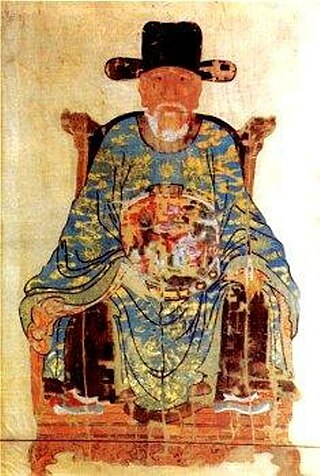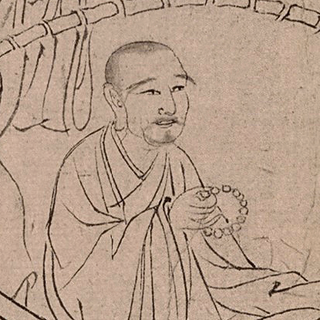Articles related to Vietnam and Vietnamese culture include:

The Lê dynasty, also known in historiography as the Later Lê dynasty, officially Đại Việt, was the longest-ruling Vietnamese dynasty, having ruled from 1428 to 1789, with an interregnum between 1527 and 1533. The Lê dynasty is divided into two historical periods: the Initial Lê dynasty before the usurpation by the Mạc dynasty, in which emperors ruled in their own right, and the Revival Lê dynasty, in which emperors were figures reigned under the auspices of the powerful Trịnh family. The Revival Lê dynasty was marked by two lengthy civil wars: the Lê–Mạc War (1533–1592) in which two dynasties battled for legitimacy in northern Vietnam and the Trịnh–Nguyễn Wars between the Trịnh lords in North and the Nguyễn lords of the South.
Trịnh Khả close advisor to emperor Lê Thái Tổ, chief ruler of Vietnam during the 1440s, and founder of the powerful Trịnh family.
Lê Nhân Tông, birth name Lê Bang Cơ (黎邦基) in Vietnam was the third king of the Later Lê dynasty from 1453 until his murder in a coup in 1459. He was a grandson of the Emperor Lê Lợi. During nearly all of his reign, the real power behind the throne was his mother, Queen Dowager Tuyên Từ, a royal consort of Lê Thái Tông.
Nguyễn Thị Anh was a concubine, and later empress dowager of Lê dynasty as the mother of the emperor Le Nhan Tong. She was official regent of Đại Việt about 1442 - 1453 during her son's minority, and effective head of state from 1451 until she allowed a servant to kill her in 1459 to avoid being captured or killed in a coup.

Nguyễn Trãi (阮廌), pen name Ức Trai (抑齋); (1380–1442) was an illustrious Vietnamese Confucian scholar, a noted poet, a skilled politician and a master strategist. He was at times attributed with being capable of almost miraculous or mythical deeds in his designated capacity as a principal advisor of Lê Lợi, who fought against the Ming dynasty. He is credited with writing the important political statements of Lê Lợi and inspiring the Vietnamese populace to support open rebellion against the Ming dynasty rulers. He is also the author of "Great Proclamation upon the Pacification of the Wu".

Dương Triệu Vũ is the stage name of Tuấn Linh, a singer on the popular Vietnamese diaspora music show Paris By Night.

Trần Nhân Tông, personal name Trần Khâm, temple name Nhân Tông, was the third emperor of the Trần dynasty, reigning over Đại Việt from 1278 to 1293. After ceding the throne to his son Trần Anh Tông, Nhân Tông held the title Emperor Emeritus from 1294 to his death in 1308. During the second and third Mongol invasions of Đại Việt, the Emperor Nhân Tông and his father the Emperor Emeritus Thánh Tông were credited with the decisive victory against the Yuan dynasty and would thenceforth establish a long period of peace and prosperity over the country.

Emperor Quang Trung or Nguyễn Huệ, also known as Nguyễn Quang Bình, or Hồ Thơm was the second emperor of the Tây Sơn dynasty, reigning from 1788 until 1792. He was also one of the most successful military commanders in Vietnam's history. Nguyễn Huệ and his brothers, Nguyễn Nhạc and Nguyễn Lữ, together known as the Tây Sơn brothers, were the leaders of the Tây Sơn rebellion. As rebels, they conquered Vietnam, overthrowing the imperial Later Lê dynasty and the two rival feudal houses of the Nguyễn in the south and the Trịnh in the north.

Đại Việt, was a Vietnamese monarchy in eastern Mainland Southeast Asia from the 10th century AD to the early 19th century, centered around the region of present-day Hanoi. Its early name, Đại Cồ Việt, was established in 968 by the ruler Đinh Bộ Lĩnh after he ended the Anarchy of the 12 Warlords, until the beginning of the reign of Lý Thánh Tông, the third emperor of the Lý dynasty. Đại Việt lasted until the reign of Gia Long, the first emperor of the Nguyễn dynasty, when the name was changed to Việt Nam in 1804. Under rule of bilateral diplomacy with Imperial China, it was known as Principality of Giao Chỉ (975–1164) and Kingdom of Annam (1164–1804) when Emperor Xiaozong of Song upgraded Đại Việt's status from principality to kingdom.
Trần Thái Tông, personal name Trần Cảnh or Trần Nhật Cảnh, temple name Thái Tông, was the first emperor of the Trần dynasty, reigned Đại Việt for 33 years (1226–58), being Retired Emperor for 19 years. He reigned during the first Mongol invasion of Vietnam before eventually abdicating in favor of his son Trần Hoảng in 1258.
Lý Thần Tông (1116–1138), personal name Lý Dương Hoán, was the fifth emperor of the Lý dynasty, reigning over Đại Việt from 1127 to his death in 1138. Becoming the ruler of Đại Việt at the age of twelve, Lý Thần Tông successfully maintained the order of the royal court and strengthened the stability of the country with the assistance of capable officials. For that reason, Đại Việt under Lý Thần Tông was able to witness a peaceful period like during the reign of his predecessors. However, Lý Thần Tông died at age 22 before passing the throne to his crown prince Lý Thiên Tộ.
The 3rd Politburo of the Workers' Party of Vietnam (WPV), formally the 3rd Political Bureau of the Central Committee of the Workers' Party of Vietnam (Vietnamese: Bộ Chính trị Ban Chấp hành trung ương Đảng Lao động Việt Nam III), was elected at the 1st Plenary Session of the 3rd Central Committee in the immediate aftermath of the 3rd National Congress.
Lê Thần Tông was the 17th emperor of Vietnamese Later Lê dynasty.
Ngô Thị Ngọc Dao posthumous name Quang-thục Trinh-huệ Khiêm-tiết Hòa-xung Nhơn-thánh Dowager Empress (光淑禎惠謙節和沖仁聖皇太后), was a queen consort of Later Lê dynasty and mother of the Vietnamese emperor Lê Thánh Tông.
Empress Nguyễn may refer to:

Nguyễn Xí, or Lê Xí, was a general, politician, and public servant who served as a minister for four generations of rulers during the late Lê dynasty.

Imperial Concubine Phi Yến, born Lê Thị Răm, is a controversial local legend of the Côn Đảo archipelago, Bà Rịa–Vũng Tàu province. According to the legend she was the concubine of Lord Nguyễn Phúc Ánh and gave birth to a son known as Prince Cải, she advised Lord Ánh not to ask foreigners for help as that would make their victory less glorious and might cause issues in future, these comments caused Lord Ánh to be suspicious of her motives and to lock her up in a cave. Later when their toddler asked where his mother was he killed him. She grieved their son and later committed suicide as she was touched by a butcher during a vegetarian festival seeing it as "harming her honour as a concubine". This caused the villagers of Côn Đảo to hold a festival in her honour every year.

The 7th Central Committee of the Communist Party of Vietnam (CPV) was elected at the 7th CPV National Congress. It elected the 7th Politburo and the 7th Secretariat.









